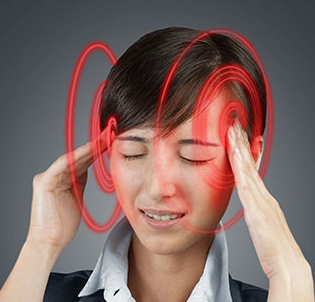Having pain in your head, whether it is a headache or migraine, can be very disconcerting and make life tougher. Adding vertigo or dizziness to the equation can make it hard to work, drive, and function.
The causes (or differential) for Headaches and Vertigo are similar. A previous post discusses the some of the key causes of headaches and migraines: https://drcremers.com/2014/02/migraine-diet-recommended-and-not.html
If you have Headaches, Vertigo, Racing Pulse, the differential narrows down a bit, with POTS
Postural Orthostatic Tachycardia Syndrome (POTS) (see below) or an Autoimmune Disease (see below) as something that needs to be looked into in particular (my MD friend had this at Harvard and it took years of visits to doctors all over the country to finally get a diagnosis. She had to be intubated as she stopped breathing before they got the diagnosis correct). Still most of the causes below can be the culprit behind Headaches, Vertigo, Racing Pulse.
The goal to finding the cause will be to rule out all the most common causes and asking your MD to be sure you do not have POTS or an autoimmune disease.
Let’s start with some definitions:
1. What is Vertigo? Vertigo is a general term used to describe a sensation that you are spinning or that the world around you is spinning when neither you nor your environment is spinning.
More formally:
A. Spontaneous vertigo including:
- •
-
Internal vertigo, a false sensation of self-motion, and
- •
-
External vertigo, a false sensation that the visual surround is spinning or flowing
E. Head motion-induced dizziness with nausea. Dizziness is characterized by a sensation of disturbed spatial orientation. Other forms of dizziness are currently not included in the classification of vestibular migraine.
2. Dizziness is used to describe a range of sensations, such as feeling faint, woozy, weak or unsteady. Dizziness that creates the false sense that you or your surroundings are spinning or moving is called vertigo.
3. Unsteadiness (a sense of imbalance or staggering when standing or walking). This sometimes is called disequilibrium
4. Lightheadedness or feeling as if you are about to faint (pre-syncope; syncope is when you actually faint). This may mean there is a heart problem or low blood pressure.
The Most Common Causes of Vertigo
| A. At least five attacks fulfilling criteria below B. Headache attacks lasting 4–72 hours C.Headache has at least two of the following characteristics: D.During headache at least one of the following: E.Not attributable to another disorder |
| Postural Orthostatic Tachycardia Syndrome (POTS) |
- Spinning
- Tilting
- Swaying
- Unbalanced
- Pulled to one direction
- Feeling nauseated
- Abnormal or jerking eye movements (nystagmus)
- Headache
- Sweating
- Ringing in the ears or hearing loss
Treatment for Vertigo
17.
POTS
Postural Orthostatic Tachycardia Syndrome;
| Postural Orthostatic Tachycardia Syndrome (POTS) is a form of dysautonomia that is estimated to impact between 1,000,000 and 3,000,000 Americans, and millions more around the world. POTS is a form of orthostatic intolerance that is associated with the presence of excessive tachycardia and many other symptoms upon standing.1
Diagnostic Criteria Signs and Symptoms Quality-of-Life and Disability History of POTS POTS Classifications Other researchers have described POTS based on some of its more prominent characteristics: hypovolemic POTS, which is associated with low blood volume; partial dysautonomic or neuropathic POTS which is associated with a partial autonomic neuropathy; and hyperandrenergic POTS which is associated with elevated levels of norepinephrine.1,3,4 These are not distinct medical conditions and many POTS patients have two or three of the different characteristics present. For example, one patient can have neuropathy, low blood volume and elevated norepineprhine. Who Develops POTS? Is POTS Caused by Anxiety? What Causes POTS? While researchers are still working to identify the root causes and pathology of POTS, there are several underlying diseases and conditions that are known to cause or be associated with POTS or POTS like symptoms in some patients. This is a partial list: -Amyloidosis;1 Treatment Prognosis The longest follow-up study done to date comes from Mayo Clinic.20 Mayo Clinic did a survey of their pediatric POTS patients seen between 2003 and 2010. Of those who responded to the survey, 18.2% reported a complete resolution of their POTS symptoms, while 52.8% reported persistent but improved symptoms. Male patients were twice as likely to report recovery. The average survey respondent had been diagnosed for about 5 years. Both patients who fully recovered and those who did not had mental health scores similar to the national norm.
VESTIBULAR MIGRAINE:
Is a relatively recent (within last 20 years) syndrome, meaning it is a group of symptoms lumped together and has no clear blood work that can label it a disease as of yet. Similar to migraine, there is no clinical or laboratory confirmation for VM. How do you diagnosis VM? 1. Vestibular migraine 2. Probable vestibular migraine A. At least 5 episodes with vestibular symptoms of How does a migraine affects the vestibular system? No one has done a high-quality treatment trial as of yet. Thus for VM or Migraine Associated with Vertigo, the goal for now is to treat the underlying migraine. |
Differential diagnosis
Menière’s disease
Benign recurrent vertigo
Treatments
Vestibular migraine.
Abstract
KEYWORDS:
Establishing a “Vestibular Migraine Diagnosis Questionnaire” and Testing Its Validity.
Author information
- 1Departments of *Neurology †Physical Medicine and Rehabilitation ‡Otorhinolaryngology, Head and Neck Surgery §Biostatistics and Medical Informatics, Ege University Medical School, İzmir, Turkey.
Abstract
OBJECTIVE:
BACKGROUND:
MATERIALS AND METHOD:
RESULTS:
CONCLUSIONS:
More clues but in Forgein Journals:
[Clinical characteristics of 100 vestibular migraine cases].
Abstract
OBJECTIVE:
METHOD:
RESULT:
CONCLUSION:


